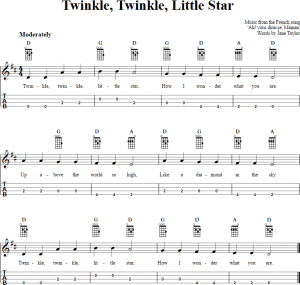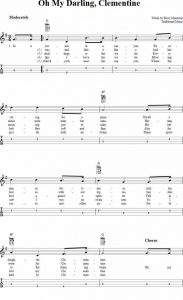Baritone ukulele is a great sounding instrument that is a wonderful alternative to the concert ukulele or even a guitar. In fact, the tuning is exactly like the guitar’s top 4 strings. This puts the baritone ukulele in a unique position. It can fill the role of either a ukulele – playing mostly strumming patterns. Or the guitar, with the ability to play more leads and chords. In this guide on how to read baritone ukulele tabs. And you will see how to take advantage of this possibilities provided by the baritone ukulele. You’ll also learn how to use the abundance of resources for both ukulele and guitar. Let’s dive in!
The Lines of Baritone Ukulele TABs
The first part of reading tablature, or TAB for short, is understanding the layout and how it relates to the layout of the instrument.
Let’s try an experiment. Take your ukulele, and flip it so it faces you. This should put the string that was closest to your face while holding to play now at the bottom. And the string furthest from your face as you play at the top. This is the exact layout of TAB. The bottom line represents the 4th string and the top line represents the 1st string.
Baritone Ukulele Tuning
After that little visual, let’s tune your instrument. Use your favorite tuning app or clip-on tuner. Or if you’re old school, you can use your tuning fork and tune to the following notes:
String 4 = D,
String 3 = G
String 2 = B
String 1 = E
These are just like the top 4 strings of the guitar.
You can use a mnemonic to help you remember the letters in order. Some examples would be, Don’t Grow Big Elephants or Donkeys Grow Big Ears. The crazier you can make the visual, the easier it will be to recall. Have fun with it and come up with your own!
The fact that the baritone ukulele is tuned exactly like the top 4 strings of the guitar allows for smoother melodic patterns and more common chord voicings. You can even take guitar chords and apply them to the baritone ukulele to get the same chord.
The Fret Numbers
Now, to the numbers on the strings. Let’s try another experiment to help remember how this works.
Pick any string to play on and begin by playing that string open. That means you won’t have any frets held down. Next, place a finger on the fret closest to the head and play the string again. Then, move the finger along the string to the next fret, then the next, then the next, and so on. Listen as you do this. Does the pitch get higher or lower as you move from the head toward the sound hole? That’s right – it moves higher. Keep this in mind when thinking about the numbering of the frets. As the pitch goes up, the fret numbers get higher. As the pitch goes down, the fret numbers get lower until you run out of fret on that string at the open position.
So, when you see numbers on a line representing a string, those indicate the fret to hold down. The higher the number, the higher the sound.
Simple Example
Let’s see an example of a simple melody written out in baritone ukulele TABs. We start with a very recognizable melody so the rhythms and the sound you are going for is already in your head. Remember, the lower line is the D string and the “0” means play the string open without holding down a fret. The next notes are on the 3rd string or “G” string and played by holding down the 2nd fret.
Continue with the rest of the song by checking the string and fret number.
Practicing Rhythm
Congratulations on playing your first melody on the baritone ukulele! One last element of TAB worth mentioning is the rhythm. Most professionally produced music material provides us with standard music notation (the symbols and lines above the TAB part in the example above).
Standard notation is not necessary to learn in order to play ukulele, but learning to read and understand the note values is great for rhythm. That skill would allow you to play a song without knowing how it goes solely based on reading it.
However, most baritone ukulele TABs out there on the internet are not written with note values or standard notation included. Instead, you must learn to decipher rhythms based on what you hear in recordings of the song. TAB gives you the notes and the order but does not do a great job at giving you the rhythm. Listen intently to the songs you are learning and follow along with the TAB to give you a better idea of how long to hold each note you see.
Understanding the basics of rhythm in music is also very helpful. Thankfully, we are all born with an innate sense of rhythm!
Final Experiment
For our final little experiment, let’s figure out how to place a song into a rhythmic structure. We’ll take another familiar song to help make this easier. “Oh, My Darling Clementine,” is an easy song to find a recording of by doing a quick search on your favorite video site. Go ahead and queue a version up. When you listen to your video try the following:
- Tap along and bob your head – just as you would when really enjoying a song.
- Now, try counting out loud to your taps. Music is structured as repeating counts called measures or bars. Each measure has a count to a certain number and that count is repeated over and over until the song is done. That is the beat of the song. The most popular counts are to 4 or 3.
- Listen as you count out loud and notice if it seems to line up to the song or if it feels off. Trust your instincts – you will know if it is off or if it sounds on.
- Keep trying until you feel it fits the feeling of the song. Try a different number to count to. Try starting the count at a different tap – the tap that you count as 1 will make a difference.
- If you don’t get it, don’t give up. This is a skill that can be developed with relative ease. You just need to keep practicing.
Keep Going!
As you can see from the TAB below, the measures are counted in 3’s. Try counting 1-2-3 to each tap and listen to how it matched the feeling of the song. The count is indicated at the beginning of the standard notation with the ¾ marking. Again, this is not often given to you as you look up TAB online, so keep practicing with counting out loud to every song you hear as you go about your day, and watch how fast you can find the count.
Baritone ukulele TABs are easy to understand and a great way to learn songs. Practice with familiar songs at first to get used to reading the TAB and figuring out the rhythms. Learn to listen and find the count to songs by practicing counting out loud. Remember you can also use guitar TAB and chords to play on the baritone ukulele – just ignore the other 2 strings on the guitar part. After that, the sky’s the limit!
Justin Martinez



